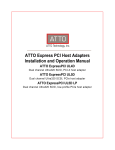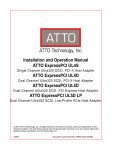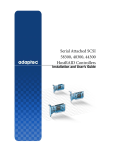Download Dell 2450 Server User Manual
Transcript
! Throughout this guide, blocks of text may be accompanied by an icon and printed in bold type or in italic type. These blocks are notes, notices, cautions, and warnings, and they are used as follows: NOTE: A NOTE indicates important information that helps you make better use of your computer system. ! " " # $%&$%& ! " " # ____________________ Information in this document is subject to change without notice. © 2000 Dell Computer Corporation. All rights reserved. Reproduction in any manner whatsoever without the written permission of Dell Computer Corporation is strictly forbidden. Trademarks used in this text: Dell, the DELL E COM logo, and PowerEdge are trademarks of Dell Computer Corporation; Intel and Pentium are registered trademarks of Intel Corporation. Other trademarks and trade names may be used in this document to refer to either the entities claiming the marks and names or their products. Dell Computer Corporation disclaims any proprietary interest in trademarks and trade names other than its own. August 2000 P/N 06NWC Rev. A01 This document updates information on the following topics for your Dell PowerEdge 2450 system: Installing and removing expansion cards Small computer system interface (SCSI) hard-disk drive support Installing an upgrade microprocessor in PowerEdge 2450 systems To install an expansion card, perform the following steps. $%&' " ( " 1. Turn off the system, including any attached peripherals, and disconnect the system from the electrical outlet. 2. Prepare the expansion card for installation, and open the system doors. )*+ , - See the documentation that came with the expansion card for information on configuring the card, making internal connections, or otherwise customizing the card for your system. 3. Check any cables connected to expansion cards through the back-panel openings. Disconnect any cables that will not reach to where the cage must be placed upon removal from the chassis. . /, support.dell.com Dell PowerEdge 2450 Systems Information Update 1-1 securing lever expansion-card cage 4. Locate the expansion-card cage securing lever (see Figure 1-1). Rotate the lever upward until it stops in an upright position. 5. Lift the expansion-card cage up and away from the chassis. 6. Open the expansion-card latch (see Figure 1-2) and remove the filler bracket from the expansion slot. expansion-card latch expansion card card guide card-edge connector expansion-card connector riser board 1-2 Dell PowerEdge 2450 Systems Information Update expansion-card cage 7. Install the new expansion card. Position the expansion-card cage so that the riser board lies horizontally on your work surface. Insert the card-edge connector firmly into the expansion-card connector on the riser board, until the card is fully seated. 8. When the card is seated in the connector and the card-mounting bracket is aligned with the brackets on either side of it, close the expansion-card latch. 9. If the expansion card is a full-length card, secure the inner end of the card by closing the latch on the card guide over the top edge of the card. 10. With the securing lever in the upright position, lower the expansion-card cage into place until it is aligned. 11. Rotate the securing lever downward until it is flush with the top of the chassis. Make sure the riser board is fully seated in the RISER connector on the system board. 12. Reconnect any cables you removed in step 3. See the documentation that came with the card for information about its cable connections. 13. Close the system doors, and then reconnect the system and peripherals to their AC power sources and turn them on. To remove an expansion card, perform the following steps: 1. To release the expansion card from the card cage, rotate the expansion-card latch away from the expansion-card bracket. 2. If the expansion card is a full-length card, release the card's inner end by opening the tab on the card guide (see Figure 1-2). 3. Grasp the expansion card by its top corners, and carefully remove it from the expansion-card connector. 4. If you are removing the card permanently, install a metal filler bracket over the empty card-slot opening. NOTE: Installing a filler bracket over an empty expansion slot is necessary to maintain Federal Communications Commission (FCC) certification of the system. The brackets also keep dust and dirt out of the system and aid in proper cooling and airflow inside the system. support.dell.com 5. Replace the expansion-card cage in the chassis as instructed in steps 10 through 12 of the previous procedure. 6. Close the system doors, and then reconnect the system and peripherals to their AC power sources and turn them on. Dell PowerEdge 2450 Systems Information Update 1-3 Your system’s integrated SCSI host adapter supports the Ultra3 (also known as Ultra160) SCSI standard as defined by the SCSI Trade Association. The Ultra3 SCSI standard supports a combination of new SCSI performance and manageability enhancements to increase data throughput up to 160 megabytes per second (MB/sec). For specific information about the Ultra3 SCSI standard, see the SCSI Trade Association Web site at http://www.scsita.org. Your system employs an implementation of Ultra3 (Ultra160) known as Ultra160/m. The Ultra160/m and Ultra3 (Ultra160) drives supplied by Dell are identical and are interchangeable. The subsections describing SCSI and redundant array of independent disks (RAID) settings in “Using the System Setup Program,” of your Dell PowerEdge 2450 Systems User’s Guide have been combined to read as follows: SCSI/RAID Controller Selections are RAID Enabled, SCSI Enabled, and Off. When you set the SCSI/RAID Controller to RAID Enabled, Channel A displays RAID and Channel B displays SCSI. When you set it to SCSI Enabled, Channel A and Channel B display SCSI. When you set it to Off, Channel A and Channel B display Off. When installing the SCSI backplane daughter card as addressed in “Installing HardDisk Drives,” of the Dell PowerEdge 2450 Systems Installation and Troubleshooting Guide, make sure to slide in the daughter card until it clicks and then lock the card into place by closing the retention lever on the card’s front edge. !"#$ This section provides instructions for: Removing the single edge contact (SEC) cartridge and heat sink Installing the new SEC cartridge and heat sink Before you perform any of the procedures in this section, take a few moments to read the following warning for your personal safety and to prevent damage to the system from electrostatic discharge (ESD). $%&( 0 Before you start to work on the system, perform the following steps in the sequence listed: 1. 1-4 Turn off your system and any devices. Dell PowerEdge 2450 Systems Information Update 2. Ground yourself by touching an unpainted metal surface on the chassis, such as the metal around the card-slot openings at the back of the system, before touching anything inside your system. While you work, periodically touch an unpainted metal surface on the system chassis to dissipate any static electricity that might harm internal components. 3. Disconnect your system and devices from their power sources. Also, disconnect any telephone or telecommunication lines from the system. Doing so reduces the potential for personal injury or shock. In addition, take note of these safety guidelines when appropriate: When you disconnect a cable, pull on its connector or on its strain-relief loop, not on the cable itself. Some cables have a connector with locking tabs; if you are disconnecting this type of cable, press in on the locking tabs before disconnecting the cable. As you pull connectors apart, keep them evenly aligned to avoid bending any connector pins. Also, before you connect a cable, make sure both connectors are correctly oriented and aligned. Handle components and cards with care. Don’t touch the components or contacts on a card. Hold a card by its edges or by its metal mounting bracket. Hold a component such as a microprocessor chip by its edges, not by its pins. " 1 0 ! (2" 3441!567!8+ " 344167!+ 2 " 9::67! Before shutting down your system, perform these preliminary steps: Record the system configuration settings. Update the embedded server management (ESM) firmware. Update the basic input/output system (BIOS), if necessary. Use the resource configuration utility (RCU) diskette to save the RCU configuration settings (see your User’s Guide for complete information). During the upgrade procedure, you must use a wrist-grounding strap for ESD protection. support.dell.com Dell PowerEdge 2450 Systems Information Update 1-5 View the system configuration screens in the System Setup program and make a record of the settings. If an ESM firmware diskette is included with the upgrade kit, update your ESM firmware with the version contained on that diskette by performing the following steps. The latest version of the ESM firmware is available at http://support.dell.com. 1. Insert the ESM firmware diskette into the diskette drive. 2. Reboot the system. 3. Follow the instructions on the screen after the system completes the boot routine. The message appears on the screen. 4. Remove the ESM firmware diskette from the diskette drive and follow the instructions on the screen to reboot the system. If a BIOS diskette is included with the kit, update your BIOS with the version contained on that diskette by performing the following steps. The latest version of the BIOS is available at http://support.dell.com. 1. Insert the BIOS diskette into the diskette drive. 2. Reboot the system. 3. Follow the instructions on the screen after the system completes the boot routine. 4. After the message appears on the screen, remove the BIOS diskette from the diskette drive and follow the instructions on the screen to reboot the system. Use the RCU diskette provided with the kit to save the current system configuration settings by performing the following steps: 1. Insert the RCU diskette into the diskette drive and reboot the system. 2. Press <Enter> when the Welcome screen appears. The Main menu is displayed. 3. 1-6 Select Step 5: Save and Exit, and then follow the online instructions to save the current system configuration information. Dell PowerEdge 2450 Systems Information Update NOTE: The RCU recognizes microprocessors operating at 450 MHz and faster. The latest version of the RCU is available at http://support.dell.com. ( *+ 6- *';' - 1. Turn off the system, including any attached peripherals, and disconnect the power cable from the electrical outlet. 2. Open the system cover. See your system’s Installation and Troubleshooting Guide for specific instructions, if needed. 3. Remove the air blower, if present (see Figure 1-3). a. Unplug the Y-shaped air blower power cable from the interposer board. b. Position your right thumb on the outside of the power supply enclosure beside the narrower front part of the air blower. c. Push firmly on the power supply enclosure to move it slightly away from the air blower and allow extra clearance to remove the air blower. d. With your left hand, pull the front of the air blower upward and away from the power supplies to unseat it. You should hear it unsnap. By pulling the air blower slightly away from the power supplies, you avoid the need to use excessive force to clear the power supply enclosure. e. support.dell.com Slide the air blower slightly up and toward the front of the chassis until the metal tab at the back right of the air blower slides out of the small slot at the top back of the chassis. Dell PowerEdge 2450 Systems Information Update 1-7 air blower power supply enclosure tab slot air blower power cable 4. Remove the SEC cartridge and heat sink as follows. ) <21 ' $ ) <"< < 1-8 a. Pull the tab on one side of the guide-bracket assembly away from the end of the heat sink and pull up slightly on the SEC cartridge and heat sink (see Figure 1-4). b. Pull the tab on the other end of the guide-bracket assembly to disengage the tab on the heat sink. Then lift the SEC cartridge and heat sink away from the guide-bracket assembly (see Figure 1-4). Dell PowerEdge 2450 Systems Information Update heat sink SEC cartridge tab guide-bracket assembly !"!# $ %& !""# 2 " 9::67! 1. support.dell.com Slide the SEC cartridge and heat sink into the guide-bracket assembly and firmly seat them in the assembly until the tabs snap into place over the ends of the heat sink (see Figure 1-5). Dell PowerEdge 2450 Systems Information Update 1-9 heat sink SEC cartridge tab guide-bracket assembly % '!"!# $ %& 2. 1-10 Replace the air blower, if it was removed in step 3 of the previous procedure (see Figure 1-3). a. Position your right thumb on the outside of the power supply enclosure beside the narrower front part of the air blower. b. Push firmly on the power supply enclosure to move it slightly toward the power supplies, allowing extra clearance to install the air blower. c. Hold the air blower above the heat sink while tilting the back of the air blower slightly down and toward the back of the chassis. d. Slide the metal tab at the back right of the air blower carefully into the topmost slot at the top back of the chassis. e. With your left hand, push down firmly on the front of the air blower until you hear it snap into place. f. Make sure that the top of the air blower is level; if it is not level, lift out the air blower and reinstall it making sure the tab goes into the slot at the very top of the back chassis. g. Plug in the Y-shaped blower power cable to the connector on the interposer board. 3. Replace the system cover. 4. Reconnect your system and peripherals to their power sources. Dell PowerEdge 2450 Systems Information Update





















